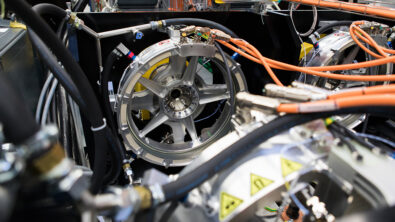Reaching Closed-Loop Optimization Part Two – Transcript – Talking Aerospace Today

In this episode of Talking Aerospace Today, Todd Tuthill and Thierry Olbrechts continue their conversation from last time on closed-loop optimization, exploring its benefits beyond design and why companies should start investing in optimization capabilities now.
Patty Russo: Greetings. Welcome to another episode of Talking Aerospace Today from Siemens Digital Industries Software. I’m Patty Russo. I’m responsible for global marketing of the aerospace and defense vertical here at Siemens. Thank you for joining today’s conversation. In our previous episode, we discussed the final stage of the digital transformation maturity journey. We’ve discussed how closed-loop optimization can help companies in the A&D industry move toward advanced digital transformation journey. We also explored how it can connect the isolated design processes of the space industries past. Today, we pick up where we left off, so let’s get right into the next question for Thierry.
Patty Russo: What came to mind as you were talking about that example about the Saturn program. Closed-loop optimization is not just about design, it’s about all facets of a program, from design to from product design systems design. You just talked about simulation in terms of, you know, structural sorts of design, manufacturing processes, sustainment service, et cetera. It’s a connected, way throughout an entire product life cycle to optimize not just a component, not just a product, but entire program through the life of that program. As we look at space, we’re looking at democratization of space. We’re looking at reusable programs and products and rockets in space. Can you give an example either in current reality or what is the potential in the future, how this can benefit further benefit a customer and when you’re looking at that entire life cycle, including the sustainment or service side, because that’s where the holy grail, if you will, is.
Thierry Olbrechts: Indeed, Patty. Closed-loop optimization, it’s not just about the design and the simulation of the individual components and the integrated aerospace system. It of course also includes the complete manufacturing process, whether it’s the manufacturing engineering process as well as the processes in place during the real production on the shop floor, once the program is basically in full production phase that. There’s a lot of data that becomes available, whether it’s from the shop floor or whether it’s from the product in service. All that data, when you’re capable to basically take that data and bring it back, create a closed-loop towards the front end of the development. There’s a huge potential to learn not only for the current program, but also for the future programs.
Thierry Olbrechts: And there’s very nice examples that we can give, where, for instance, simulation models are not only used to basically fit or give input towards the design phase of the development, but where data that comes from the spacecraft in operations, where data comes back and where that data is actually being used to check whether the spacecraft system is working nominally or whether there’s some kind of defects that might occur maybe. That might lead to some early maintenance on components or certain major systems.
Todd Tuthill: Yeah, and Patty, if I if I could add something there. I don’t know how many scuba divers we have on the podcast, but I learned to scuba dive back several years ago, and one of the key things that the scuba instructor told us he said, you know, “You’re going to be 70 feet 100 feet under the ocean” He said, “Problems that happen at that depth have to be solved at that depth.” Because if you scuba dive you know about decompression, and if something happens, you know, even though the surface is just 70 or 100 feet away, if I just immediately swim to the surface, my lungs explode. So I got to fix problems, and the thing that occurred to me as true was talking about space is we launched these spacecraft, whether it’s the space station or orbit or something to the moon or something to Mars.
Todd Tuthill: And when those spacecraft are out there, whatever problems they have, they have to be fixed where they’re at, and that simulation that Theirry’s talking about, that digital twin becomes very, very important at that point because, the controllers, whether it’s controllers it used in or the employees at SpaceX are some private company, the astronauts on station are having a problem. The engineers need to understand different scenarios. They can’t just build something and send it up. They’ve got to figure it out.
Patty Russo: So what we were just talking about suggests that what’s changed is the scope and scale. What’s changed is the ability to make some connections that weren’t there years ago. But one thing that has not changed is the thousands and millions of decisions that go into not only to the design of the aircraft or spacecraft, but also the tens of millions of decisions that go into the maintenance or problem solving once in use. And what that leads me to is the number of people that are traditionally, that were traditionally required to make all of those decisions going back to that Apollo example that Thierry offered, 400,000, and that 10x reduction in the number of people required to develop a new space product.
Patty Russo: Where does closed-loop optimization fit into continuing or building on this progress? We’ve got this workforce challenge. We’ve got all of these opportunities ahead of us with technology, and as I mentioned, the democratization of space. How does this concept, and in fact reality in many ways today of closed-loop optimization, help us build on this progress?
Thierry Olbrechts: Indeed, Patty. When you look at the Apollo program, for instance, when you look at the Grumman corporation who developed the moon lander, actually there were a lot of engineers actually involved in designing the moon lander. I believe that at the top of the program there were 3000 engineers actually doing the design of the individual components up to the complete spacecraft, but there was a lot of overhead. So there was the engineers making the drawings and each of the drawings were physically handed over to the group leader. The group leader handed it over to the draftsman, who were actually doing some kind of checking of the drawings. They handed it over to the release group, who basically also negotiated with the analysis folks and to check whether the thermal vibration stress side was okay, and then there were casually handed over to the manufacturing environment. So there was a huge overhead. Physical actions were actually happening in order to develop that moon lander.
Thierry Olbrechts: Today, digitalization actually helps to reduce the overhead and reduce the manual, might be digital manual kind of interactions that are needed in order to come to the right design. In the same way today we, see that a lot of the processes might be digital or a lot of tools in the development chain might be digital, but a lot of manual email kind of interactions are happening, which today with a digitalization platform can be avoided. And there’s a lot of examples we have. For instance, our jet engine customers who really start to benefit from the fact that doing the development, doing the design, doing the fluid and thermal analysis simulation, doing the structural simulation, doing the turbine blade lighting simulation on one platform actually allows to speed up a very much the development. You don’t have this manual handovers anymore and once you can reduce the manual handovers, whether it’s through email or whether it’s through pointing to a certain disk in the environment when you can basically use a digital backbone to accelerate that.
Thierry Olbrechts: That already brings a lot of capability, and now put that in context of what Todd said when you can basically use that digital backbone to connect all the models together, to automate certain workflows, to put optimization capabilities around these workflows, and while not connected to machine learning kind of capabilities, you will be able to reduce the development time in a very significant way, and why not go to again at 10X reduction of the let’s say amount of employees needed in order to develop that?
Todd Tuthill: So, and Patty and Thierry, if I could follow up on that to kind of build on the things both of you have said. When I think about where aerospace has come in the last 60 years, you know roughly we’ve gone from 400,000 people to 40,000 people to create a large space program. And I think the question on the table is how do we get to four? What’s it going to take to do that next order of magnitude jump? And I think about all the advancements that’s happened across aerospace in the past 60 years. Thierry talked about the simulation capabilities we have now to look at ways to solve the kinds of instability problems we had on the Saturn V. That’s certainly one way, but think about so many others. Computers 60 years ago filled a room. Now computers fit on my wrist, and we can put computers and we do all over all of our products.
Todd Tuthill: I think about the advances in materials and just so many things, but like Patty and Thierry talked about, there’s one key thing that I think really hasn’t changed that much in 60 years, and it’s that the thousands and millions of decisions that happen in a big design and development program like the Apollo program or like designing a new aircraft, those thousands and millions of decisions are made by, largely, by human beings. And they’re communicated largely manually among teams, large teams, hundreds or thousands of engineers, and it takes time to communicate all the information. Thierry talked about a lot of it happens by email or it happens on shared drives, and when I think about the advancements scenario space, the thing that I see that we’re lacking the most is the automation in the ability to make those decisions, and the automation to communicate those decisions very, very quickly.
Todd Tuthill: And to me, that’s the real heart and promise of closed-loop optimization. I’m not implying that human engineers don’t make high level decisions. They still do. Human engineers will still set objectives. Human engineers will still evaluate the overall outcome of that, but I think the vast majority of those smaller decisions about how designs happen about how designs are communicated about how trade trades happen within a design space. I think the vast majority of those can be fully made by a computer, can be evaluated by a computer and those evaluations can be fed back and made better. And to me, that’s the heart of closed-loop optimization, and that’s the place that we need to go as an industry to solve our workforce problem and to really get to the point where we can fully optimize our systems. And that’s the promise of closed-loop optimization.
Thierry Olbrechts: Absolutely, Todd. And when you look at the different digitalization capabilities that are available today, let’s say very advanced guide, kind of simulation capabilities become more and more accessible to more engineers. We talked about democratization of simulation capabilities, and this will combined with the digital backbone, and using that digital backbone in context of development that will allow to give engineers more time to spend real engineering time, creative time finding solutions for the mission that needs to be developed. Does that make sense?
Todd Tuthill: Yeah, I think so. Yeah. So, Thierry, I agree and I hope our listeners can see now that we’re coming to the end of this series how the five pieces of digital transformation maturity really fit together to create this place where we can dramatically, dramatically impact the time it takes and to do large engineering product projects and the ability to really optimize them quickly. It’s all five pieces working together.
Patty Russo: Yep, and that actually is dovetails nicely into as Todd you mentioned, we’re reaching the end of this episode, but before we get there, I have one follow up and close to final question. Todd, you talked a little bit about where closed-loop optimization is taking the industry and where digital transformation maturity fits kind of on a higher level, with the promise and the opportunity as we talked a little bit of course about some examples, and then Thierry you just shared a couple of practical applications of advanced capabilities and what’s available today from simulation to that traceable chain of data on a digital backbone. One of the things that we get a lot, whether it be on a customer conversations about things like this or other communications like webinars, one question we always get at the end of these types of conversations is, “Okay I’m in. I love it. How do I start? Where do I go?”
Patty Russo: So, what recommendations might you provide to listeners in determining what their on ramp is when they’re looking at this promise of digital transformation maturity and this promise of that Holy Grail at the end the fifth step, the closed-loop optimization? What’s what recommendations might you have to listeners on finding their on ramp?
Todd Tuthill: Yeah, Patty, my answer to that question is always the same. It’s two words. “Don’t wait.” Sometimes people look at this and we’re talking futuristic about, you know, computers completely designing spacecraft and aircraft, and certainly I can’t go to a generative AI program today and say, “Design an aircraft for me, please.” And an aircraft pops out. We’re not there. Now, I think there’s a time coming in the future where a large sections, large subsections, if not entire products, will be able to be generated to generatively designed. We’re not there yet, but so much of what we talked about day of the technologies we’ve discussed today and on this podcast, so much of that already exists. It exists in large measures within single domains. So there’s so much opportunity. Understand, as a customer understand where you’re at with your digital transformation and then plot a course for where you need to go, and then start. That’s always my advice.
Patty Russo: And plotting a course in terms of where they currently are and where they’re perhaps biggest opportunity or biggest need is relative to that five levels of digital transformation maturity. Have they adopted the configuration piece? How connected are they, et cetera? So kind of doing that assessment, right? Don’t wait to do that assessment. Thierry, do you have anything that you’d like to add to that before we wrap up today’s episode?
Thierry Olbrechts: I fully agree with Todd. Just start today. All the capabilities that are needed are already available today. We keep on improving this keep capabilities or on a daily basis. Already today, customers are benefiting and are accelerating on the digital maturity ladder, I would call it. With the different capabilities that are available. There’s multiple examples, for instance, where customers are starting to use AI and machine learning on top of the physical simulation capabilities to come sooner and more rapidly to an optimized blade and a turbine engine in an aircraft. So it does not yet happen, as Todd already explained at the full aircraft level, in a very automatic way. But let’s say on key systems and key aspects, the capabilities today are available to take the right steps towards more integrated, more automated optimization and make the connection to the closed a loop optimization that we have been talking about today.
Patty Russo: Outstanding. So my summary is, don’t wait to begin the assessment process and look at where you are and where your biggest opportunity is, and then don’t be afraid to look at other peers or other companies within the industry, whether it be space or commercial aircraft, because there are lots of different examples of where the digital transformation stages and customers in the industry have already adopted. Great conversation today. Thank you both Todd and Thierry for the incredible insights and enlightened discussion, and a sincere thanks to all of our listeners for joining us. We hope this conversation has helped you learn more about what closed-loop optimization is in the context of the digital transformation maturity stages as we wrap up or begin to wrap up the series on the topic. I’m Patty Russo and we do look forward to having you join us on our next episode of Talking Aerospace Today.
Siemens Digital Industries Software helps organizations of all sizes digitally transform using software, hardware and services from the Siemens Xcelerator business platform. Siemens’ software and the comprehensive digital twin enable companies to optimize their design, engineering and manufacturing processes to turn today’s ideas into the sustainable products of the future. From chips to entire systems, from product to process, across all industries. Siemens Digital Industries Software – Accelerating transformation.


